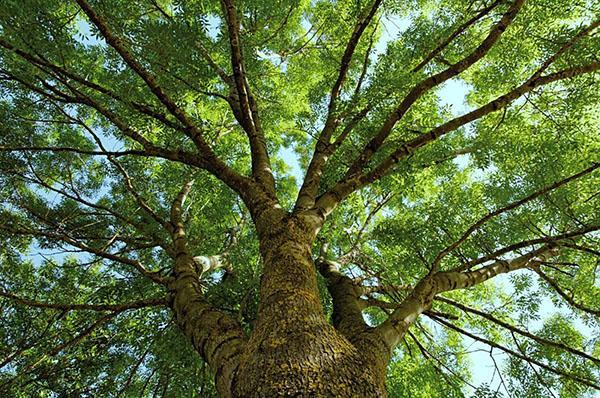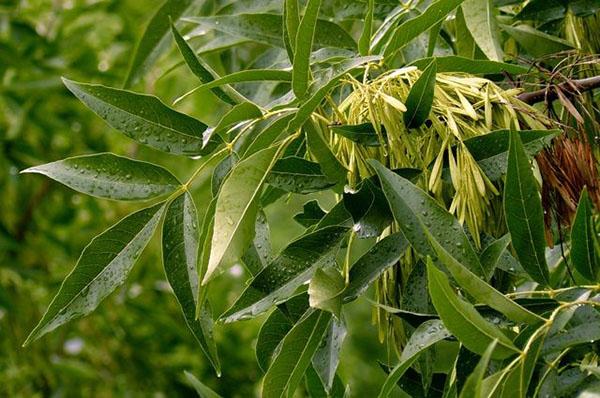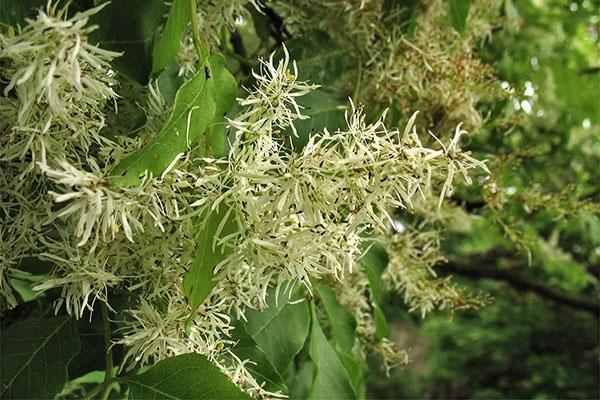The healing properties of ash and its use in traditional medicine
 The healing properties of ash are a real storehouse of useful substances that help with various diseases. In folk medicine, all parts of the plant are used, including the bark, leaves, fruits and inflorescences. Useful decoctions and infusions are prepared from them for the treatment of muscle pains, diseases of the digestive, vascular and respiratory systems, general strengthening of immunity. Raw materials can be prepared independently or purchased in pharmacies - ash extract is even added to some drugs that are not inferior in effectiveness to synthetic substances.
The healing properties of ash are a real storehouse of useful substances that help with various diseases. In folk medicine, all parts of the plant are used, including the bark, leaves, fruits and inflorescences. Useful decoctions and infusions are prepared from them for the treatment of muscle pains, diseases of the digestive, vascular and respiratory systems, general strengthening of immunity. Raw materials can be prepared independently or purchased in pharmacies - ash extract is even added to some drugs that are not inferior in effectiveness to synthetic substances.
Ash - description and characteristics

The plant is used in construction, the manufacture of various interior items and musical instruments. Due to the healing properties of ash, it is widely used in folk and traditional medicine.
They are due to its unusual chemical composition:
- leaves contain various vitamins (including vitamin C), useful carbohydrates, saponins, salts, essential oils, resins and bitterness;
- fruits are rich in fats and proteins, as well as vitamins C and P;
- bark is a source of carbohydrates, mannitol, alkaloids and other components.
Ash juice can be obtained in the spring season. It contains a huge amount of vitamins and is used as a sugar substitute for diabetes.
Ash medicinal properties and recipes
 Due to its medicinal properties, ash is widely used in folk medicine. For the manufacture of decoctions and infusions, you can use its bark, leaves and fruits - they contain active substances in maximum concentration.
Due to its medicinal properties, ash is widely used in folk medicine. For the manufacture of decoctions and infusions, you can use its bark, leaves and fruits - they contain active substances in maximum concentration.
Various remedies based on extracts of this plant are indicated for the following pathologies:
- tuberculosis - the leaves contain a natural antibiotic that is active against its pathogen;
- diseases of organs and systems caused by fungi and protozoa;
- joint diseases, including rheumatoid arthritis;
- disorders of digestion, liver and kidney function;
- nephrolithiasis - kidney stones;
- varicose veins.
Ash fruit and leaf extract has a pronounced anthelmintic effect. In addition, it purifies the blood and is recommended as an additive to hot drinks.
It can be taken not only for treatment, but also for the prevention of many diseases and for the general strengthening of the immune system.
The use of bark in medicine
 Ash bark is strong, gray in color, with characteristic cracks and patterns. It is used after drying and grinding, in powder form. All active ingredients are preserved in this form, and when brewed, they enter the water. Infusion of the bark is recommended for colds, which are accompanied by an increase in temperature, as well as for inflammatory processes in the body. Also in folk medicine there are recipes that are useful for tuberculosis and indigestion, which are prepared using this component.
Ash bark is strong, gray in color, with characteristic cracks and patterns. It is used after drying and grinding, in powder form. All active ingredients are preserved in this form, and when brewed, they enter the water. Infusion of the bark is recommended for colds, which are accompanied by an increase in temperature, as well as for inflammatory processes in the body. Also in folk medicine there are recipes that are useful for tuberculosis and indigestion, which are prepared using this component.
Ash Bark Universal Recipe:
- pour 2 tablespoons of powder with a glass of boiling water;
- keep on low heat for 10-15 minutes;
- cool and drain;
- take during the day in small portions, at least half a glass per day.
The medicinal properties of ash bark are also known in official medicine. So, in many countries (Germany, Switzerland) you can find preparations based on it.
Ash leaves
 Ash leaves are a valuable source of vitamins and other beneficial elements. Despite the fact that they appear on trees only in the warm season, they can be taken in winter - it is enough to dry and grind the raw materials. A drug based on them has a mild laxative and anthelmintic effect, and is also recommended for pain in muscles and joints.
Ash leaves are a valuable source of vitamins and other beneficial elements. Despite the fact that they appear on trees only in the warm season, they can be taken in winter - it is enough to dry and grind the raw materials. A drug based on them has a mild laxative and anthelmintic effect, and is also recommended for pain in muscles and joints.
You can prepare it according to a simple recipe:
- pour a spoonful of dry raw materials with a glass of boiling water;
- insist in warmth for 10-15 minutes;
- strain and drink three times a day, 1 glass.
Ash leaves can be taken orally as a powder. This way they will retain the maximum amount of active substances that will be fully absorbed by the body. With pancreatitis, it is useful to eat half a spoonful of dry crushed leaves, 30 minutes before meals.
Fruit based recipes
 Ash fruits are lionfish. They are often used as an alcoholic tincture to treat varicose veins. For this, 50 g of fruit is poured with 500 ml of alcohol and insisted for at least 2 weeks. This tool is applied to damaged areas as compresses and rubbing.
Ash fruits are lionfish. They are often used as an alcoholic tincture to treat varicose veins. For this, 50 g of fruit is poured with 500 ml of alcohol and insisted for at least 2 weeks. This tool is applied to damaged areas as compresses and rubbing.
There is also a recipe for decoction of ash fruits: pour 20 g of raw materials with boiling water, boil for 30-40 minutes, cool and strain. This is a concentrated remedy, so it is enough to drink 3 tablespoons three times a day. The recipe is effective for varicose veins and other vascular diseases.
Regular intake of a decoction of ash fruits will cleanse blood vessels and improve the properties of blood, prevent it from thickening and the formation of blood clots.
Contraindications for use
 Despite all the benefits and a wide range of actions, ash-based preparations should be taken only after consulting a doctor. The plant is poisonous, therefore, exceeding the dosage or improper preparation of medicines can cause poisoning.
Despite all the benefits and a wide range of actions, ash-based preparations should be taken only after consulting a doctor. The plant is poisonous, therefore, exceeding the dosage or improper preparation of medicines can cause poisoning.
In addition, before consuming any ash extracts, it is important to ensure that there are no contraindications, including:
- hypertension - increased blood pressure;
- atherosclerosis - a disease that occurs with a decrease in elasticity and gradual destruction of the walls of the arteries;
- allergic reactions - plant parts, especially pollen, are common and strong allergens.
The healing properties of ash and contraindications to its use are known in traditional medicine. The plant is useful for the treatment and prevention of diseases of many organs and systems, has anti-inflammatory, anthelmintic, antibacterial action. It can be easily assembled and stored on your own for use at home, but you should consult with your doctor before use.